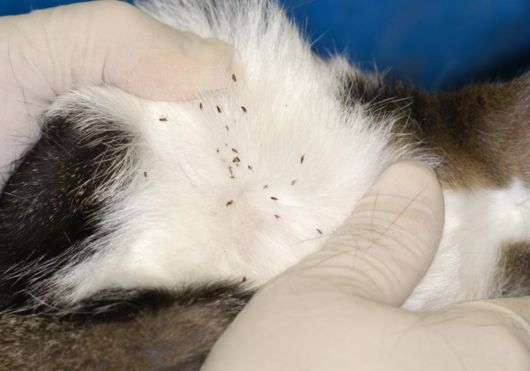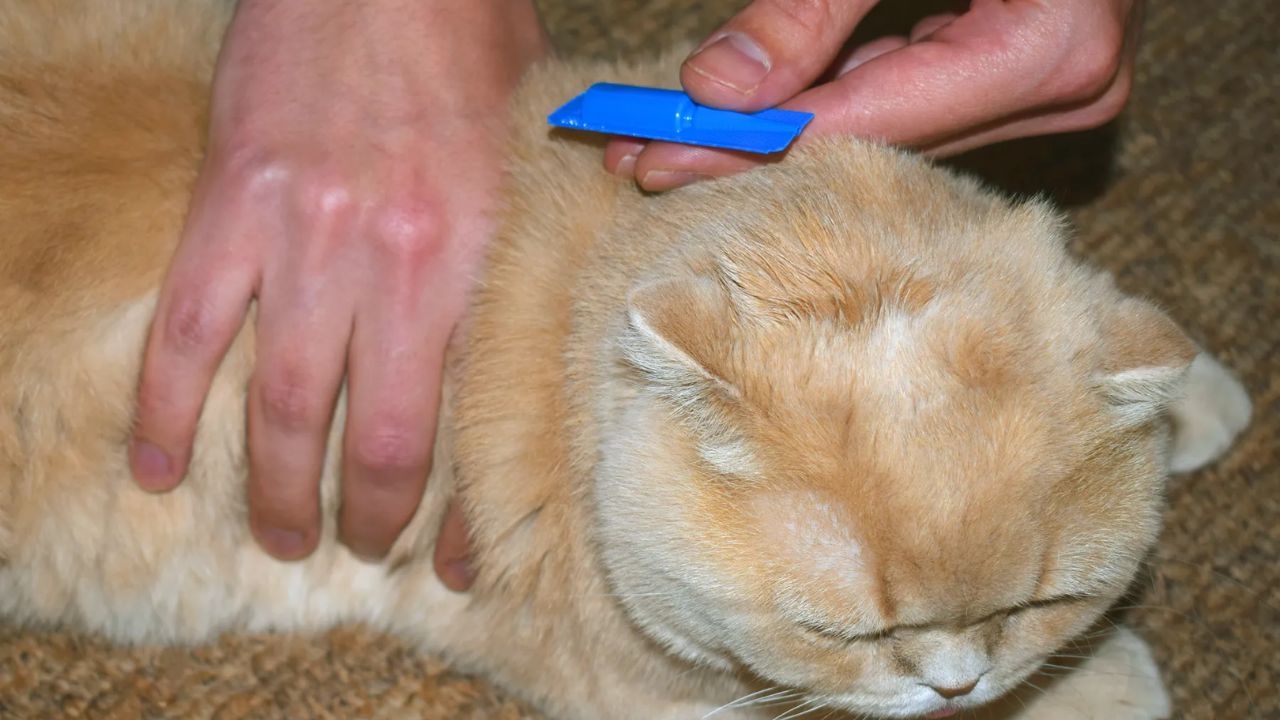Cat fleas are small bugs that bite and suck blood, making cats itch and feel uncomfortable. If there are many fleas or your cat is allergic to flea bites, they might lose fur and get sores. These fleas can also spread sickness to both cats and people.
Learn how to spot fleas on your cat, get rid of them, and stop them from coming back.
What Are Fleas?
Fleas are small bugs that live on animals and feed on their blood. While thousands of flea types exist, the cat flea is the most common one found on pets like cats and dogs. Their thin bodies and powerful legs help them jump onto animals and move through their fur while drinking blood.
Flea Life Cycle
Female fleas lay about 20 eggs daily. When these eggs hatch, the baby fleas (larvae) eat flea droppings found on cats and nearby areas for a few days. Then they wrap themselves in a protective shell and grow into adults. These shells are tough and can survive pest control treatments. The developing fleas can stay inactive inside their shells for days to months until they find a cat or other animal to feed on.
What Types of Diseases Can Fleas Transmit?
Fleas are known to carry several pathogens, some of which can affect both cats and humans:
- Cats can get tapeworms from eating fleas, but these parasites rarely spread to humans.
- When cats scratch or bite people, they can pass on cat scratch disease. While cats usually don’t get sick from this bacterial infection, humans can.
- Plague comes from fleas that usually live on rodents. Though cats aren’t common carriers of these fleas, there’s a small chance they could spread the plague to both cats and humans.
- Cat fleas can carry typhus bacteria. We don’t know much about how typhus affects cats, but it can make people sick.
Symptoms of Fleas in Cats
Fleas don’t always cause obvious signs in cats, but itching and skin irritation will develop when a cat is allergic or sensitive to flea saliva. Common signs of fleas on cats include:
- Scratching
- Excessive grooming
- Red bites or scabs
- Hair loss
- Flea dirt (excrement that looks like black specks) on the skin, fur, or bedding
- Skin infection
If your cat is scratching, check for fleas by running your fingers or a flea comb through their fur, focusing on the head, neck, and tail area.
Even if you can’t find fleas or their droppings, your cat might still have them. Cats often eat fleas while cleaning themselves, which makes fleas harder to spot.
Fleas can do more than just irritate your cat’s skin. They can spread diseases and cause anemia from blood loss, especially in kittens with many fleas.
What Causes Fleas on Cats?
Outdoor cats often get fleas while roaming outside, as fleas naturally live where cats go. Indoor cats can also get fleas when they come into the house on people or other pets. Your cat is more likely to get fleas if:
- Moist, wooded surroundings
- Long grass
- Indoor flea infestation (carpets, bedding)
- Neighboring flea problems (especially in apartment complexes)
- Moving to a new home that previously had fleas (pupae may suddenly emerge and infest)
How Do Vets Diagnose Flea Infestations?
Vets usually find fleas by looking at your cat’s fur. They separate the hair to spot adult fleas or their droppings. Even if there are very few fleas, vets might notice other signs like tapeworm pieces in your cat’s poop, which shows fleas are present.
How to Treat Cats With Fleas
Getting rid of fleas needs a complete plan. You must kill both adult fleas and their eggs, and clean your home too. Start by using a special flea comb or giving your cat a bath to remove as many fleas as possible.
If your cat doesn’t like baths, don’t push it. When using a flea comb, drop the fleas into soapy water to kill them so they don’t jump back onto your cat.
The most important step is talking to your vet about which flea treatment to use. There are many options you can give your cat by mouth or put on their skin, and new treatments become available often.

Warning
Don’t put dog flea treatments on cats. Dog flea products can poison cats, causing seizures or death.
Getting rid of fleas is hard work because you need to tackle the problem in several ways:
- All household pets need to be treated with an effective flea control product.
- The home environment must also be treated for fleas.
It takes a few months to fully remove fleas from both your cat and home. If you stop treating them too early, the fleas will quickly come back.
How Do You Get Rid of Fleas at Home?
To get rid of fleas for good, clean your home to remove fleas and their eggs. Here’s what to do:
- Wash all bedding in hot water. While the bedding is in the wash, vacuum the mattress carefully, focusing on cracks where eggs might be hiding.
- Vacuum your carpets every day and throw away the vacuum bags after use.
- Use a steam cleaner on carpets to kill any eggs that remain.
- If these steps don’t work, you might need to call a pest control service. Ask them about their products to make sure they’re safe for pets.
Prognosis for Cats with Fleas
After getting rid of fleas, cats usually get better quickly. Their itching stops, cuts heal, and fur grows back.
If fleas were present for a long time or the problem was severe, cats might have low blood count or diseases from fleas. These issues need extra treatment for the cat to fully recover.
How to Prevent Cat Fleas
Use flea prevention on your cat all year round, with treatments given once a month. Even though fleas are more common in warm weather, keeping up with prevention throughout the year is important, especially if your cat has had fleas before. Year-round treatment also helps protect against flea-related diseases.
If you have more than one pet, make sure they all get flea treatment. Fleas can easily spread between animals, so treating just one pet won’t solve a flea problem in your home.
Are Fleas Contagious to Other Animals?
Fleas can jump between animals and infect all pets in your home. While they prefer furry animals over humans, they still bite and make people itch. Fleas can spread diseases to cats, dogs, people, and other pets like ferrets or birds.
If you think your pet is ill, contact your veterinarian right away. Always ask your vet about health concerns since they know your pet’s medical history and can give the best advice.
